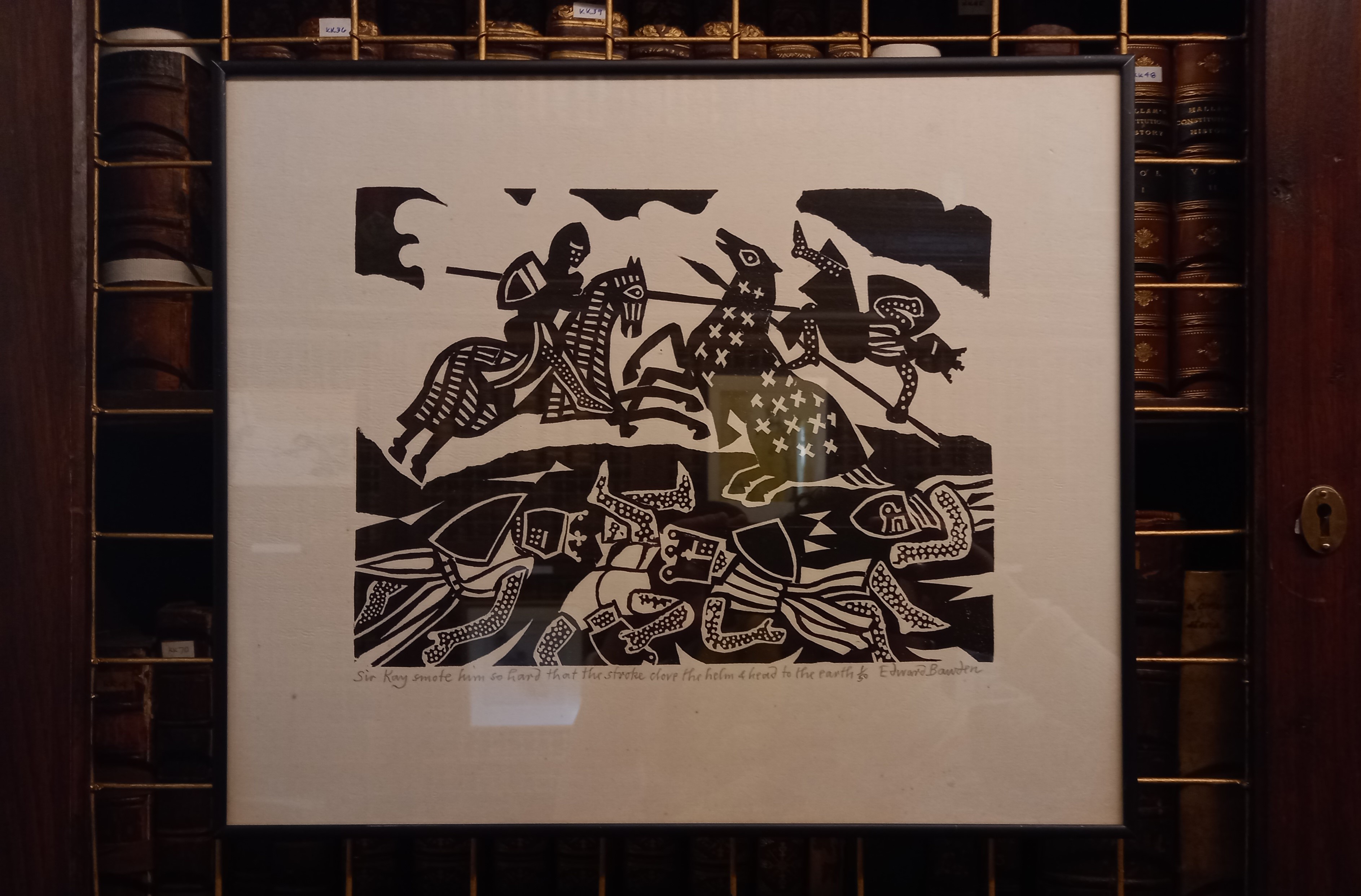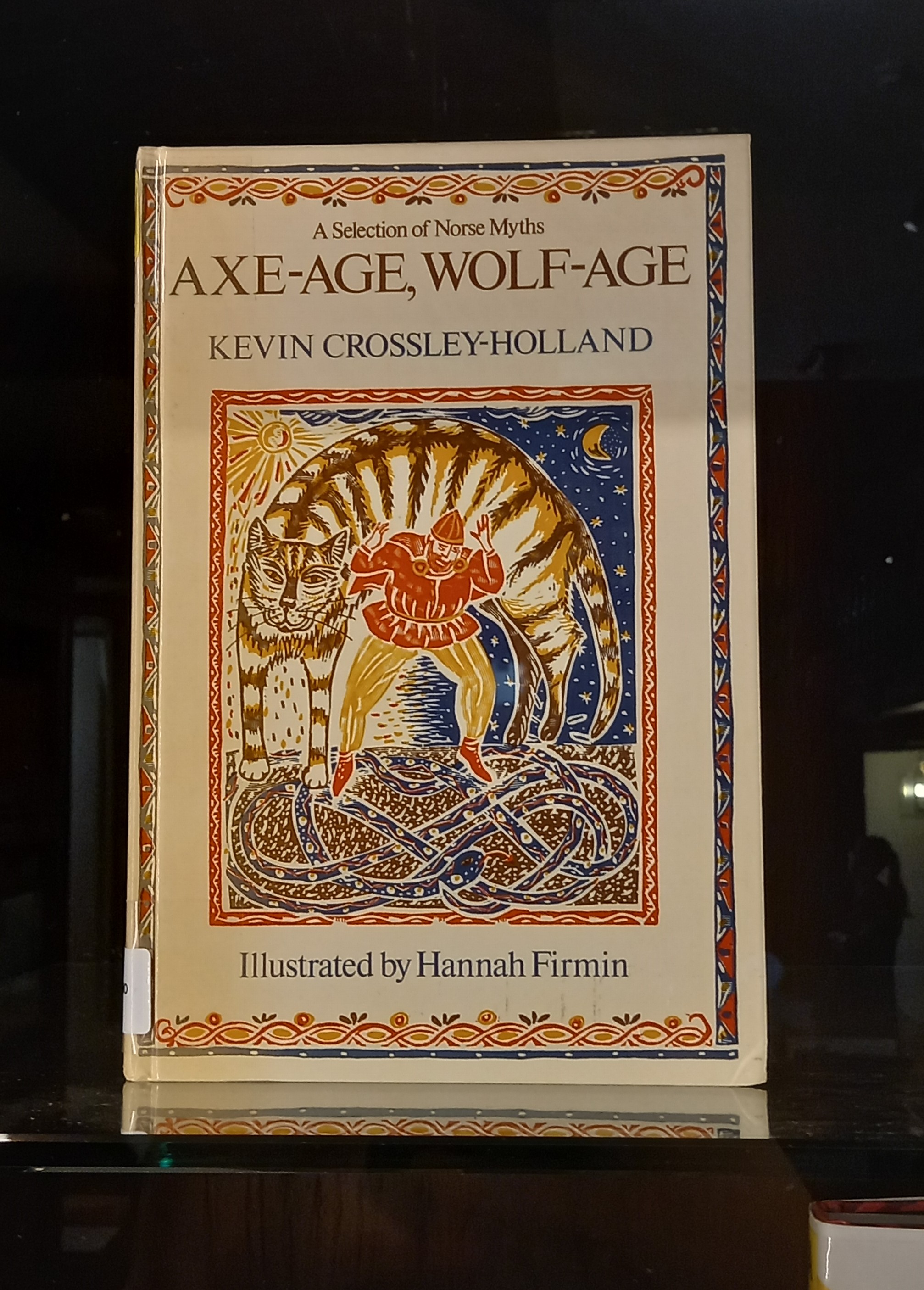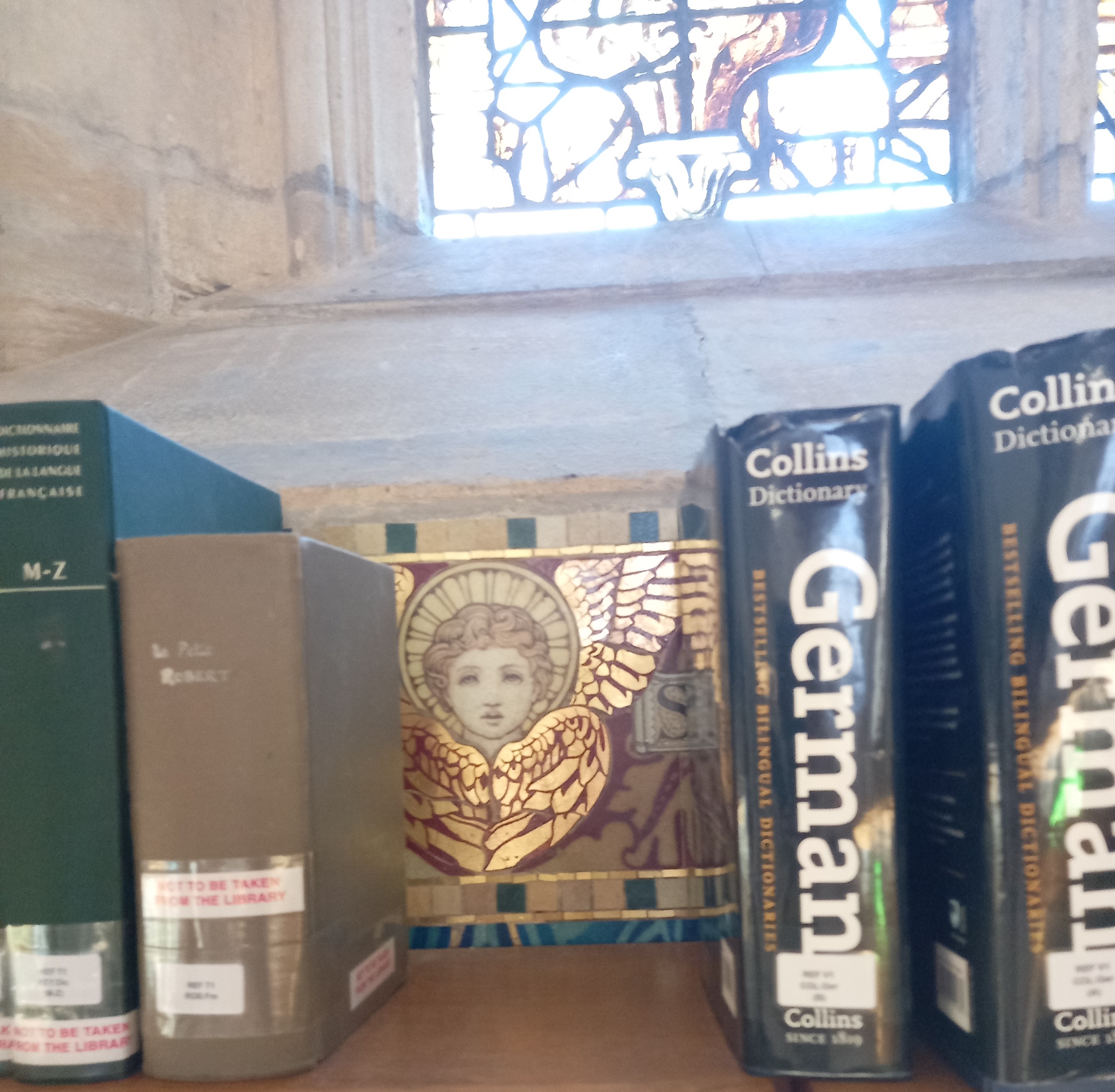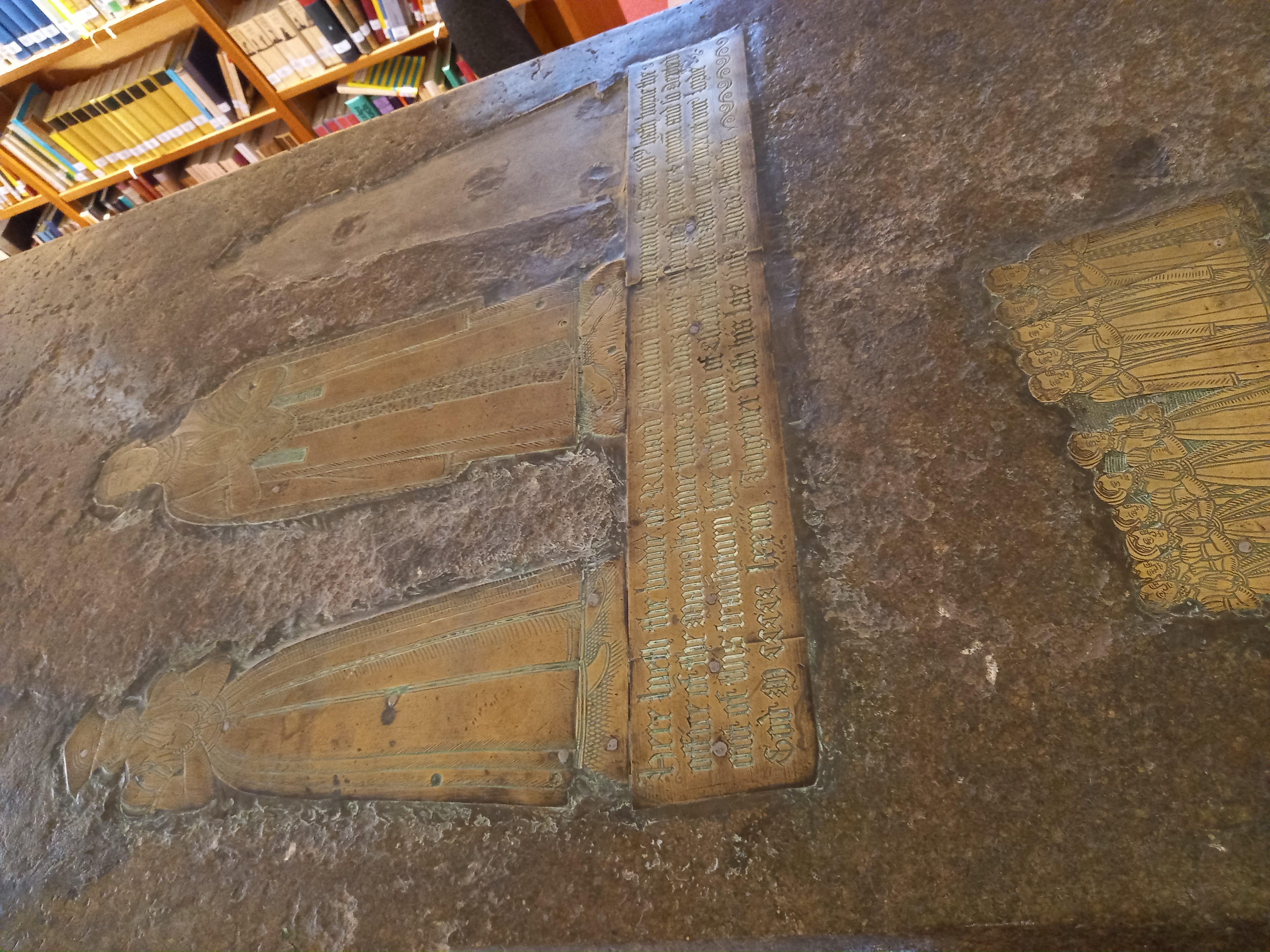In the middle of a mild October, myself and some of my fellow trainees attended a tour of the libraries at St Edmund Hall (SEH). This visit was prompted by their exhibition of ‘Poem, Story & Scape in the work of Kevin Crossley-Holland’ and also, admittedly, curiosity to see how another college organised their libraries.
When I reached out to the library team at SEH about visiting the exhibition, they very kindly offered to talk us through not just the exhibition, but also give us a behind the scenes of the Hall and its libraries (and medieval crypt! Result!)

Curated by Dr Catherine Batt, Senior Lecturer in Medieval Literature at the University of Leeds[1], the Crossley-Holland exhibition was first shown at the Stanley and Audrey Burton Gallery. Since this debut it has made its way to Oxford and, more specifically, the Old Library at SEH.
Crossley-Holland studied English at SEH and is a ‘prize-winning children’s author, translator, poet, librettist, editor and professor’[4]. I was familiar with his Arthur books from reading them as a child. These absorbing stories intertwine Arthurian legend with the story of a boy living at the turn of the 13th century who sees these myths unfolding in a lump of obsidian[5]. It could be fair to say that these books (along with the BBC’s Merlin, of course) sealed my fate with regards to my un-wandering obsession with the knight-errant.
Crossley-Holland is an honorary fellow at SEH so it seems fitting that an exhibition charting his explorations of language, place and legend would be held there, possibly where his love for all things Arthurian began.
On the day of the tour, we learnt that the library collection at SEH began under the crafty eye of Dr Thomas Tullie, who was the principal of the Hall from 1658 – 1676. He introduced a tradition by which departing students would gift the Hall with a book or silver plate worth £5. That was no small fee in those days – £5 would be what a skilled labourer would earn in 71 days![2]. These rather substantial tokens of gratitude for lessons learned at SEH shaped the collection that still survives to this day.
Before Tullie’s scheme, the Hall (the first documented reference to which dates to 1317[3]) had existed for many years without a library, but on our visit to SEH we were treated to tours of not one but two libraries, and I feel as though their addition can only have changed the Hall for the better.
The Old Library
The first stop on our tour was the Old Library – this is where the books that were gradually gifted by students as they left the Hall from the 1680s found their first home.

The books in this library cover a range of subjects and serve as a window into the tastes and tilts of the Hall’s attendees across its history. Upon our visit, yet another window into the Hall’s more recent history was open to us.
The ‘Poem, Story & Scape in the work of Kevin Crossley-Holland’ exhibition tracks the works of Crossley Holland chronologically, beginning at one end of the Old Library with books containing the Old English texts and fragments he would have studied as a student, and ending with his most recent publications. This journey through literary history and Crossley-Holland’s own academic ventures ducks and dives in and out of rabbit holes of a creative’s endless fascinations – we see explorations into photography, fiction, poetry, translation…
The closest end of the table upon entering the Old Library was laden with what felt like a crash course in Old English. I felt transported back to the beginning of my own degree in English Language and Literature, with manuscripts holding translations of Cædmon’s Hymn and many versions of Beowulf, including a translation by Crossley-Holland himself. It felt like watching the new iterations of inspiration from texts that have moved readers, writers, artists and students for hundreds of years literally spill out of these works as you moved through the room and exhibition.

Prior to starting at Christ Church as a library graduate trainee I spent some time working in a gallery. I am really interested in how the space an exhibition is displayed in influences and informs the work and the way it’s experienced. At the Old Library at SEH you spiral up a narrow staircase to a room filled with dark wood, grated bookshelves and warm light – the exhibition is just asking to be poured over.
One of my favourite aspects of the exhibition was the artworks that Crossley Holland has commissioned over the course of his career to compliment his work. Hung from the grating on the shelves, these images ranged from intricate prints to expressive illustrations.
Here are a couple of my favourites:

This piece is titled ‘Malory’ and is a lino print by Edward Bawden: bold, with a particularly playful depiction of chainmail, though a rather violent depiction of everything else…[6]. Bawden and Crossley Holland worked together on Chronicles of King Arthur.

Hannah Firmin’s pieces in Axe-Age, Wolf-Age particularly charmed me. Plus, the brightly coloured block prints in this selection of Morse Myths make for a lovely contrast to the bold black and white of Bawden’s lino prints.
Student Library
Towards the more joyfully bizarre end of the Oxford libraries spectrum we have SEH’s working library – housed in a 12th century church, St Peter-in-the-East. The church was deconsecrated in 1970, but readers in this library still work above a medieval crypt – one wonders if there is a notable influence on student’s work from such proximity…

The approach to the library is a pathway through a graveyard – a rather maudlin approach to a study session, perhaps. (If you want to become better acquainted with those lining such an expedition, SEH’s website has transcriptions of the names on the gravestones[7]). Once in the library and weaving through student desks, our guide pointed out gorgeous tiling decorated with angels – hiding, slightly shyly, behind a row of German dictionaries. Stained glass splashes the working space with colour and a stone tomb stands in line with a study desk. The bronze plates that adorn its surface were apparently pilfered from another tomb – the features of a different family are thought to be engraved on the other side!

All the accoutrements of a church used as a place of worship until 1965[8] brush shoulders with the conveniences of a modern library here, and the effect is distinctly unique. Slinking through the stacks in this library feels like embarking on a treasure hunt – can you spot all the signs of hundreds of years of history?
I’d like to finish this post by thanking the lovely library team at SEH who very kindly showed us around and shared the fascinating history of the Hall and its libraries with us – we had a wonderful time!
References:
[1] https://library.leeds.ac.uk/events/event/1900/galleries/413/poem-story-amp-scape-in-the-work-of-kevin-crossley-holland
[2] I think this is my new favourite website…https://www.nationalarchives.gov.uk/currency-converter/#currency-result
[3] https://www.seh.ox.ac.uk/discover/explore-teddy-hall/history-of-the-hall
[4] https://www.seh.ox.ac.uk/news/poem-story-and-scape-in-the-work-of-kevin-crossley-holland
[5] https://www.kevincrossley-holland.com/fiction/
[6] See more of Bawden’s work here: https://collections.vam.ac.uk/item/O88947/the-lord-of-the-tower-book-illustration-bawden-edward/
[7] https://www.seh.ox.ac.uk/discover/explore-teddy-hall/history-of-the-hall/history-of-st-peter-in-the-east/gravestone-transcriptions
[8] https://www.seh.ox.ac.uk/discover/explore-teddy-hall/history-of-the-hall/history-of-st-peter-in-the-east

0 comments on “An Expedition to St Edmund Hall”
1 Pings/Trackbacks for "An Expedition to St Edmund Hall"
[…] Thank you to James Howarth for the informative session! [See this blogpost for more information on the Kevin Crossley-Holland exhibition: http://blogs.bodleian.ox.ac.uk/oxfordtrainees/an-expedition-to-st-edmund-hall/%5D […]